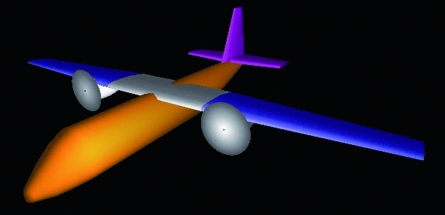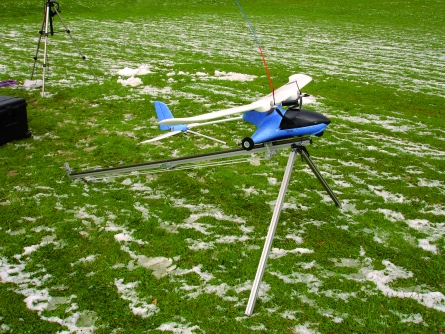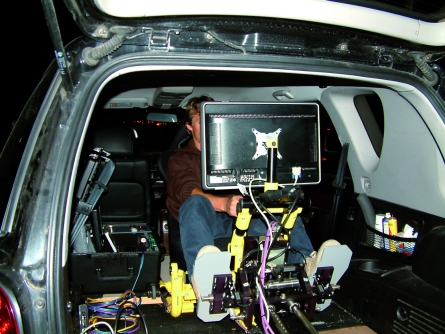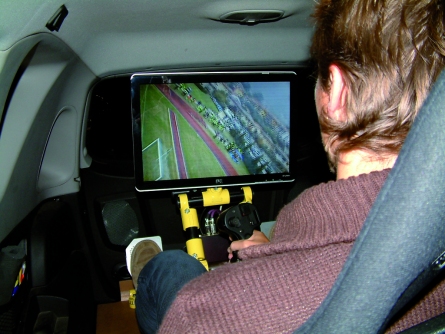A mini unmanned aircraft hooks around the corner of a ruined multi-story hotel in the hills of northern Italy as its sensors scan the rubble caused by an earthquake. Emergency response crews are still making their way over broken country and the UAV imagery is providing critical guidance on their choice of route and ongoing response planning.
While the aircraft could be operated autonomously, the earthquake has transformed the landscape and digital map data is barely relevant. Instead, the pilot is flying it in a remote profile from a miniature cockpit in the back of a four-wheel drive vehicle travelling with the rescue convoy. A real-time datalink and video goggles allow the pilot to fly at low level, reacting immediately to rapid changes in terrain and wind conditions. In minutes the UAV has flown multiple circuits, finding a route across the ravaged land and starting low-level passes by hotel windows to locate survivors.
Remote piloting is far from new, and is the primary means of flight control for current generation endurance UAVs such as the General Atomics Predator family. But remote piloting is in for a transformation, says Jarno Puff, research and development manager with Italy's Advanced Aviation Technology (A2Tech), and could become a major element of small and mini-UAV operations in the near term.
A2Tech is working on a new generation of ground control stations that use synthetic vision tools, video goggles, head-up display presentations, hands-on throttle and stick type controls and the integration of a total system optimised for use by some of the smallest classes of UAV.
The objective, Puff says, is to provide systems that can operate safely and reliably in complex terrains where human judgement, for now, provides superior navigational ability over machine intelligence.
Puff and other members of the development team began exploring the technical requirements of pilot in the loop navigation in 2002 in response to practical problems experienced while operating radio-controlled model aircraft, particularly how to safely assess air vehicle proximity to obstacles during flight and during take off and landings.
|
|---|
A2Tech's RV-160 will fly by May 2008 |
While these issues could be resolved by shifting to fully autonomous solutions for the air vehicle, this in turn removed the actual piloting experience and the flexibility that brought to how the model aircraft could be used. The initial solution explored was the use of video goggles in conjunction with normal hand-held radio control equipment. However, this was found to induce disorientation effects for the pilot. A rethink of the problem identified that the pilot should be the starting point of any remotely operated system, rather than the air vehicle. Part of that analysis process also took in the ways in which remote piloting capabilities were being used with UAVs, resulting in a decision to focus on that sector and the establishment of A2Tech in 2004 as a vehicle to commercialise the resulting systems.
MINI COCKPIT
Building the first demonstrator system took three years, resulting in a mini cockpit - what A2Tech calls its RealityVision universal ground cockpit - which replicates the forms and functions found in typical manned aircraft such as the stick and pedals, as well as a panoramic display, video goggles with integrated head-up data, and synthetic vision toolsets. The second element of the demonstrator system, an electrically powered mini-UAV designated RV-02, was adapted from a kit model aircraft with this incorporating a real time datalink, a piloting camera, and mission sensor payloads.
The demonstrator ground control system software and air vehicle avionics suite are based on CANaerospace data and communication protocols. Development partners included Michael Stock Flight Systems, Reiser Systemtechnik and Wetzel Technology.
Initial trials of the completed demonstrator began in Germany in mid-2005 with a qualified test pilot flying the system. Puff says the RV-02 UAV itself had recorded 30h of flight time to the end of October this year, while the station is used daily in simulation modes.
The RV-02 has a span of 1.4m (4.6ft) and a take-off weight of 1.9kg (4.2lb). The airframe is made of moulded expandable polypropylene
The demonstrator station and UAV have also been containerised for operational deployment as part of A2Tech plans to pursue the emergency services sector as a priority, with Italian domestic agencies an immediate focus. Italy regularly has to deal with earthquakes, landslides and other natural disasters.
The demonstrator was used by civil defence authorities in Italy's Veneto region early November this year as part of the Sisma 2007 earthquake response exercise, the first time a mini-UAV had been used in such roles.
|
|---|
Rescue demonstrator: the RV-02 and catapult launcher |
Development work has started on a second mobile ground control station. Puff says this will be used alongside the existing demonstrator station to further explore operation of UAVs in emergency scenarios where either no or only limited digital geographic information is available to the pilot.
CAMERA SUITE
For example, a UAV pilot could deploy an air vehicle in remote flight modes into a disaster area with local-area knowledge support provided by civil authority experts who would "fly" the mission as an observer. The pilot and the observer would see the same real world environment visual data collected by the UAV camera suite, presented using video goggles as well as on panoramic monitor displays.
Puff says the civil authority observer would be able to assist the pilot with knowledge of local area hazards, as well as build his own situational picture to guide response planning. By flying the UAV remotely, the pilot could progressively build a database from which waypoints for subsequent fully autonomous UAV missions could be carried out, he adds.
The absence of reliance on digital databases for the system means it can start operations far more rapidly in the field than a UAV system relying on digital data, Puff says. "Lots of civil organisations don't have access to digital mapping data. There is a lower level of IT literacy compared with the military".
|
|---|
The RealityVision universal cockpit fits into a car |
The company is also looking at the potential of the system to be used in Alpine rescue operations on Italy's northern border. Autonomous UAV flight in mountain terrain remains a major technical hurdle due to wind and rapid weather condition changes, says Puff: "It is a challenge to make UAVs fly in the mountains. Obviously you need a pilot in the loop."
Mountains can also change physically. Puff cites an October landslide in the Dolomites that sent 60,000m3 (2,120,000ft3) of stone tumbling into valleys. That sort of incident renders digital maps worthless in an instant, he says.
Mountain operations might see A2Tech experiment with rotary-wing air vehicles, but the company is now focusing on a new small fixed-wing UAV, designated RV-160. The aircraft is intended to allow exploration of flight operations with a wider range of payload types. Its first flight is expected by May 2008.
The new UAV will have a 3m span and use a carbon-composite skeleton with interchangeable carbon-kevlar skins. It will use twin-wing engine-mounted interchangeable engines with electric, piston and turbine options to be available. The wings will also host hard points for external fuel tanks or additional sensor mounts. Puff says the RV-160 nose will be modular, with this intended to support rapid change of payloads. It will incorporate a five-wheel retractable undercarriage with active shock absorption to support rough field operations.
|
|---|
A piloting camera display |
Puff says new generation CANaerospace datalinks and a range of video links are being tested as the RV-160 avionics suite is developed. In remote piloting mode an operational radius of 10km (5.4nm) from the universal ground control station is being planned.
GROUND STATION PLANS
Ongoing ground station development includes plans for scaled-up versions, with A2Tech eyeing potential links to a variety of large UAV development efforts in Europe. The station could be used as part of a refurbishment of existing UAV systems. Puff says, allowing development of wider operational capabilities without major changes to those aircraft.
The small size of the existing ground station has also seen thinking about development of a version that could be carried inside another aircraft to allow for manned/unmanned teaming operations. Puff says experimentation using the RV-2 UAV and using a light aircraft to host the existing ground station is being considered. One of the objectives of that effort would be to determine what impact the physical sensation of being in flight in one aircraft might have on a UAV pilot/passenger who is simultaneously engaged in immersive control of a second air vehicle. There are multiple scenarios where the two aircraft would be involved in such fundamentally different flight profiles that the UAV pilot could become disorientated or distracted, he says.
Puff is also interested in options for increased sensory inputs into the ground station when it is being used in the fully immersive mode, including audio data. "Noise is an essential part of human perception. Sound is essential for the pilot. If you have a closed immersive environment, you need images and audio," he says.
Manned aircraft pilots already use sound as to gain a feel for individual aircraft characteristics, as do car drivers. Fitting a microphone into the fuselage of a UAV and feeding that data into the pilot's headphones could be one way of achieving that input, says Puff, although it would have to be balanced against bandwidth demands on the datalink system.
Source: Flight International



























